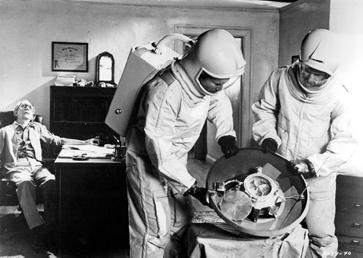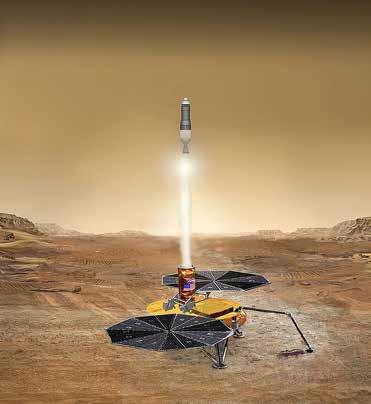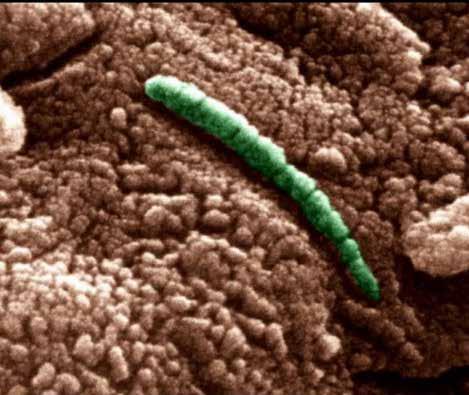
11 minute read
NEWMedia
from MUFON Journal - June 2020
by MUFON
T. L. KELLER
ALH84001 a Martian meteorite found in the Allan Hills region of Antarctica in 1984 by a team of American meteorite hunters from the ANSMET project. bacteria tiny creatures making up a division of microorganisms that are typically one-celled, have no chlorophyll, multiply by simple division and can be seen with a basic microscope. DNA deoxyribonucleic acid is a molecule composed of two chains that coil around each other to form a double helix carrying genetic instructions for the development, functioning, growth and reproduction of all known organisms and many viruses on Earth. Mars Sample-Return NASA and European Space Agency mission planned to return soil samples from Mars in the early 2030s. The current plan incorporates the collection and storage of soil samples by NASA’s Perseverance rover vehicle. The samples then would be returned to Earth much later on a Mars Sample-Return mission. microbe microscopic organism. Any bacterium that causes disease. pathogen any agent, especially a microorganism able to cause a disease.
Advertisement
RNA ribonucleic acid is a polymeric molecule essential in various biological roles in coding, decoding, regulation and expression of genes. RNA and DNA are nucleic acids, and, along with lipids, proteins and carbohydrates, constitute the four major macromolecules essential for all known forms of life on Earth.
virus nucleic acid (ultra-microscopic), either DNA or RNA, encased by protein. Viruses infect animals, plants and bacteria and can reproduce only within living cells.
The Andromeda Strain
Could a worldwide pandemic result from the Mars Sample-Return mission?
Background
One of this writer’s favorite, classic sci-fi films is Robert Wise’s The Andromeda Strain (1971), based upon Michael Crichton’s fictional book of the same title. The plot goes something like this: an American satellite is launched in order to capture upper-atmosphere microorganisms for biological warfare research. However, in the process, a meteor carrying extraterrestrial microbes crashes into the satellite, taking it out of orbit. One of the damaged satellite components containing the microbes then parachutes to a remote New Mexico town. As a result of aerial reconnaissance, it appears that all of the townspeople have died— well, all but two: a six-month-old infant and a 69-year-old, alcoholic man living on aspirin and Sterno.
Drs. Stone and Hall discover the satellite debris containing alien microbes1
The microbes contain the chemical elements (carbon, hydrogen, oxygen, nitrogen—the constituent elements in amino acids) required for terrestrial life, but lack the DNA, RNA, and the amino acids present in all forms of terrestrial life. They have the unusual ability to transform matter directly into energy with no apparent byproducts. The satellite components and the microbes are taken to a top-secret, underground laboratory in Nevada called the Wildfire containment facility. The microbes, code-named “Andromeda,” mutate with each growth cycle, changing their biological properties. Unexpectedly, they also have the uncanny ability to degrade synthetic rubber and plastic seals in laboratory doors
thereby permitting them to “escape captivity” from the containment facility (!). One thing that we clearly understood was that the story involved a highly-virulent microbe quite unlike any terrestrial bacterial or viral agent. (See sidebar.) Another thing is that there is risk in most human endeavors, particularly involving the unknown and that unexpected events can result, even some involving all of humanity. The movie ends with Dr. Stone testifying before Congress that, while they were able to defeat the alien pathogen, they may be unable to do so in the future. It’s a foreboding message sent out in 1971 and recalled by some of us amid the ongoing pandemic in 2020. According to Wikipedia, a 2003 publication by the Infectious Diseases Society of America noted that The Andromeda Strain is the «most significant, scientifically accurate, and prototypic of all films of this [killer virus] genre . . . it accurately details the appearance of a deadly agent, its impact, and the efforts at containing it, and, finally, the work-up on its identification and clarification on why certain persons are immune to it.”2
Mars Sample-Return Mission
A Mars sample-return (MSR) mission would be a spaceflight mission to return rock and soil samples on Mars to Earth for detailed analysis. The samples, under this proposed plan, would be collected by the Perseverance rover and then retrieved and returned years later by an MSR mission. Sample-return would be a very powerful type of exploration, because the analysis is freed from the time, budget, and space constraints of normal, unmanned spacecraft sensors. The illustration below is one scenario planned by NASA/JPL and ESA. This mission is currently planned for the early 2030s. Of course, the mission will be moot if Elon Musk’s SpaceX lands a manned spacecraft on Mars in 2024 as planned (!).

Mars Sample Containment
So, what if there’s a certain bacterial agent or virus that is returned to Earth? Is there a risk that what was depicted in this film could actually have an impact like coronavirus on Earth? For those of a certain age, we remember what happened when the crew of Apollo 11 returned to Earth after landing on the Moon: they were quarantined. The purpose of the quarantine was to prevent the spread of any contagions from the Moon, though the existence of such contagions was considered unlikely, but not impossible. Neil Armstrong, Buzz Aldrin and Michael Collins were held in quarantine in the Mobile Quarantine Facility (MQF) for the first few days after returning to Earth and then for the remainder of 21 days at the Lunar Receiving Laboratory in Houston.

President Nixon visiting the Apollo 11 crew in the MQF4
Note: The following contains extensive extracts from an article written by columnist Leonard David under the byline Space Insider and published on Space.com.5 Cassie Conley, a former NASA Planetary Protection Officer, emphasized that there is far more risk in the Mars Sample-Return mission than an Apollo mission returning rock samples from the Moon. She told Space.com:
“Since the beginning of space exploration, planetary protection has mandated that samples from Mars
should be considered ‘Restricted Earth Return.’ This requires the most stringent containment to protect both the samples and the Earth.” According to Wikipedia, in 2019, NASA’s Planetary Protection Independent Review Board recommended lowering the “planetary protection” category for much of Mars’ surface to Category II, which would eliminate the requirement for oversight or containment of samples returned from parts of Mars.
“We really don’t understand Earth biology very well and certainly don’t know that much about Mars. So, it’s premature to conclude there are no Martian biohazards. . . the current pandemic demonstrates, tragically well, how overconfidence and short-term perspectives can cause catastrophic harm to people all over the Earth.”6 J. Andy Spry is a senior scientist at the SETI (Search for Extraterrestrial Intelligence) Institute in California and a NASA planetary protection consultant. Spry said that Mars sample containment would occur “in the same way that the SARS epidemic sharpened the responses of many Asian countries to the COVID-19 hazard. That is, by allowing decision-makers to develop appropriate and timely responses to a microbial pathogen threat.” Spry said that such pathogens usually develop by co-existing with life on Earth, with highly specialized outbreak adaptations as part of an ongoing host-pathogen interaction. “We can think of pathogenicity as molecular locks and keys which are virtually impossible to develop without repeated contact,” Spry said.7 “Thus, it is extremely unlikely for a biological entity evolving and adapting in an extraterrestrial environment to be able to take advantage of lifeforms on Earth.”
Why Not A Martian Testing Facility?
Dirk Schulze-Makuch, an astrobiologist at Washington State University, has been a longtime advocate for having an on-the-spot life-detection mission on Mars first, before attempting sample return. “We do have the technology to do so. That way we would also have a better idea what we might bring back,” he told Space.com. (Perseverance, which will launch this summer, will hunt for signs of Martian life on the Red Planet’s surface. But the rover will look for evidence of ancient, not extant, organisms.) Schulze-Makuch said that a retrieval facility would have to have a high biosafety level, just in case. The chance that any life from Mars would be in any way harmful to us or Earth’s biosphere at large is extremely low, he said. He thinks that chance is lower than 1%, but it cannot be totally excluded. According to him:
“So, I think the public and planetary protection guidelines would warrant a high biosafety level retrieval facility . . . which, of course, has a very high price tag as well. And since samples can only be brought back once such a facility is in operation, it will also delay the schedule until we can bring samples back. And if so, we should bring rather ‘fresh’ samples back, not samples that have been in a box on Mars for years—as is the plan right now.”8
ALH84001
One thing that must be kept in mind, Schulze-Makuch said, is that Earth has already received Mars samples—lots of them, in fact, over the eons. Many Mars meteorites have landed on Earth, potentially bringing Martian microbes—if they exist—to our planet.9

ALH84001 meteorite “fossil” or what? [colorized]10
“Studies have shown that the interior, for example, of Mars rock ALH84001 was never heated above 40 degrees Celsius [104 degrees Fahrenheit], and if there would have been (dormant) microbes in it, they would likely have survived the journey from Mars to Earth,” Schulze-Makuch said.
Since 1984, there’s been a heated debate among scientists about whether some Martian meteorites—notably ALH84001—contain evidence of Martian microbial life. “Either way, the point is that there is also a natural ‘mechanism’ to bring potentially Martian life to Earth … and if that didn’t have detrimental consequences for life in the past, it is unlikely that it will have those in the future,” Schulze-Makuch said. “But again, we have to admit that the risk is not zero.”11
A Future “Wildfire” Containment Facility?
While major spacefaring nations share a common perspective on containment of Martian material returned to Earth
by a spacecraft, J. Andy Spry also underscored the international Committee on Space Research (COSPAR) policy language that “no uncontained hardware that contacted Mars, directly or indirectly, shall be returned to Earth.”12 However, details of the implementation—including those for a containment facility—have yet to be completed, he said.
“This is only because the details of the current Mars sample return mission architecture are still being studied and refined by NASA and the European Space Agency right now,” Spry told Space.com. “In the latest scheduling, we are still some 15 years from samples actually being returned to the Earth-moon system, which is still timely in terms of getting containment facility work done.”13
Commentary
This article is a precautionary note. The coronavirus pandemic reinforces the old Boy Scout’s motto that it’s best to be prepared for unexpected events. As Jan C. Harzan wrote in the April issue of the Journal, “Black Swan events rarely give a warning—they just arrive.” We are now experiencing a worldwide Black Swan event of the first order. Disease is widespread and continuing. We will get through this, at least most of us, but far worse events could happen if NASA, ESA, CNSA (Chinese National Space Administration)—or anyone else—should become complacent. For those who are very conservative (with a small “c”), the best course of action would be to operate a testing facility on Mars prior to returning samples to Earth. For this writer, who happens to be more of a “progressive” on this issue, I have a personal sense that—for Mars—it is not necessary to create a “Wildfire” containment facility on Earth. I cannot speak for MUFON, but I subscribe to the conspiracy theory of an extant, Secret Space Program. That is, I accept the premise that there is already an existing, human presence on Mars.14 So, for me, this is all a moot point. Readers’ comments would be appreciated and will be presented in a future article.
Notes
1. Courtesy of Universal Pictures. The Andromeda Strain was nominated for two, 1971 Academy Awards: Best Art Direction and
Best Film Editing. Douglas Trumbull (2001: A Space Odyssey) provided the special effects.
2. Courtesy of Wikipedia.com.
3. Courtesy of NASA/JPL and ESA.
4. Courtesy of Wikipedia.com.
5. David, Leonard, Space Insider, “Could Mars samples brought to Earth pose a threat to our planet?,” Space.com, April 8, 2020.
6. Ibid. 9. Ibid.
10. Courtesy of astrobio.com. This original photo image was subsequently colorized for effect.
11. Op. cit., David.
12. Op. cit., David.
13. Op. cit., David.
14. Should the reader find this to be an outlandishly-crazy idea from a deranged mind, please read my “NewScience” article, “Space Warp
Propulsion—Part 2,” also in this month’s issue. Then, realize that in 1988 the ARV (Alien Reproduction Vehicle) existed in three prototype variants. It’s been 32 years since then. What further progress has been made? A Moon base? A Martian colony? Generally speaking, when science creates a new technology, engineers exploit that technology to the fullest. They don’t put it on a shelf to collect
Moon dust.
To the readers: If you have a specific topic that you would like presented, please contact the editor. l




